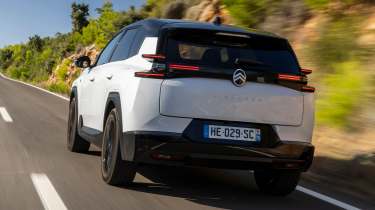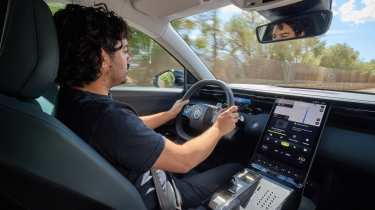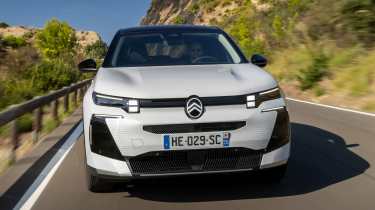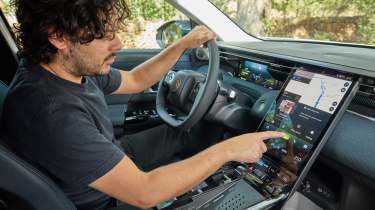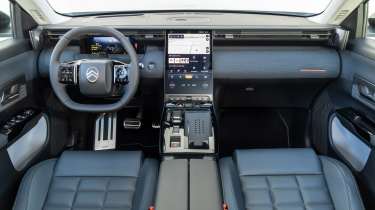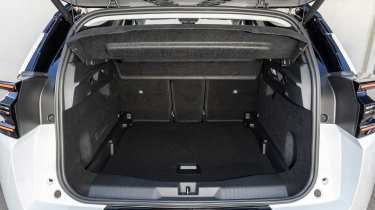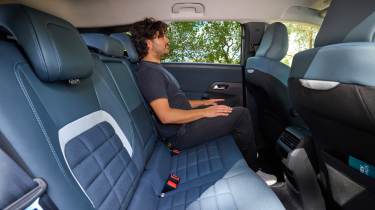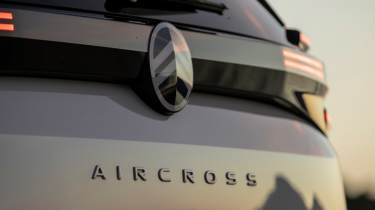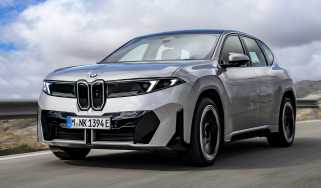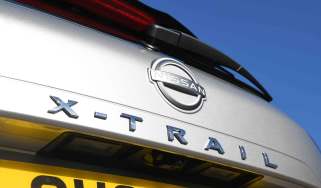Citroen C5 Aircross review
The C5 Aircross majors in traditional Citroen values. We like its comfort and practicality plus there’s good electric range and a great price

Our opinion on the Citroen C5 Aircross
The Citroen C5 Aircross could be the most complete SUV from the Stellantis group yet. It remains true to Citroen’s core values of being spacious, full of useful tech and very comfortable, but comes with one secret weapon. Citroen’s aggressive pricing strategy brings it in under most key rivals and the PCP finance rates are equally compelling. Its varied range of powertrains are also a bonus, highlighted by the new plug-in hybrid variant that finds a good balance between efficiency and flexibility.
About the Citroen C5 Aircross
The C5 Aircross is Citroen’s biggest SUV model and this second generation offering has a similar combination of comfort, space and affordability to the original car. Like all modern Citroen models, it draws most of its technology and underpinnings from within the Stellantis conglomerate, so shares lots under the skin with cars like the Peugeot 3008 and Vauxhall Grandland.
Like its sister cars, the C5 Aircross is only available in a five-seat configuration, but its boxy shape opens up a large second row and cargo space. It’s built on the same STLA-M platform, too, which opens up multiple powertrain options, from a low-cost mild-hybrid through to plug-in hybrid and full-EV variants.
Citroen C5 Aircross prices and latest deals
The Citroen C5 Aircross is a fair bit less expensive than its Stellantis group compatriots. The trim levels are as follows:
Used - available now

2023 Citroen
C5 Aircross
47,856 milesAutomaticPetrol1.2L
Cash £13,744
2023 Citroen
C5 Aircross
28,700 milesAutomaticDiesel1.5L
Cash £15,921
2023 Citroen
C5 Aircross
76,525 milesAutomaticPetrol1.6L
Cash £12,343
2020 Citroen
C5 Aircross
67,205 milesManualPetrol1.2L
Cash £9,029- You! - from around £30,500
- Plus - from around £33,000
- Max - from just under £36,000
In order to access the extra versatility of the plug-in hybrid C5 Aircross you’ll need to go for the top-spec Max trim, which is the only trim level available with PHEV power and costs just under £39,000.
The comfort range e-C5 Aircross is available across all three trim levels and is around £3,500 more expensive model-for-model, while the 97kWh long range is just over £6,000 more than its hybrid equivalent (both figures before the Electric Car Grant (ECG) discount. Crucially, the e-C5 is eligible for the government’s ECG discount, which brings the EV prices closer to those of petrol cars. The long range 97kWh versions qualifies for the full £3,750 grant, while the comfort range gets the lower £1,500 grant.
You can also make savings via our Buy a Car service, where a new Citroen C5 Aircross starts from under £24,000.
Performance & driving experience
Pros |
|
Cons |
|
Citroen is refreshingly single-minded about how its models should drive, and the C5 Aircross is no exception. This is a truly comfortable car focused on keeping its occupants as relaxed as possible. It does this through a variety of means, from the soft seats to the quiet cabin and the gentle powertrain calibration, but it all starts with the suspension.
The C5 Aircross has deliberately soft suspension that helps it glide over bumps in most situations. But Citroen has taken the tech further than just the springs and dampers. There are also hydraulic bumpstops to further help the ride quality, and the tyres feature a generous sidewall across all wheel options. We found that the all-electric e-C5 Aircross models don’t ride quite as well as the base hybrid and PHEV cars, but the difference isn’t huge.
The trade-off for this exemplary comfort is a lack of body control and engagement. But a bit of wallow in the corners and ultra-light steering is no bad thing when it comes to family cars. In fact, the only thing we’d like to see improved is for the front of the car to dive down a little less under braking, something that isn’t helped by the generally inconsistent brake pedal feel.
All C5 Aircross models have various drive modes, although we don't think its Sport mode makes much sense in a car like this. However, if you are in a hurry, it does make things feel just that little bit more connected.
Performance, 0-60mph acceleration and top speed
| Model | Power | 0-62mph | Top speed |
| Citroen C5 Aircross 1.2 PureTech hybrid | 142bhp | 11.2s | 125mph |
| Citroen C5 Aircross 1.6 plug-in hybrid | 193bhp | 8.3s | 137mph |
| Citroen e-C5 Aircross 73kWh | 210bhp | 8.9s | 106mph |
The entry-level hybrid C5 Aircross features a powertrain we know well from other Stellantis models. It’s effective but feels underpowered in a car this big. The combination of a 1.2-litre turbocharged three-cylinder engine and a small electric motor is only able to generate 142bhp, which will eventually get the Aircross to 62mph in 11.2 seconds.
It’s also not the most refined engine in the world, with a grumbly warble under load that’s not entirely in keeping with the serene nature of the rest of the car. It has at least reverted to a traditional timing chain in place of the controversial ‘wet-belt’ system.
The plug-in hyrbid powertrain feels much more in-keeping with the character of the C5 Aircross, and comes with some significant uplifts in performance and efficiency. It comes with a bigger and more powerful 148bhp 1.6-litre turbocharged four-cylinder petrol engine, and works with a 124bhp e-motor fed from an 18kWh battery pack. Peak combined power is 193bhp, which isn’t massive, but performance is improved dramatically over the base car with an 8.3-second 0-62mph time.
In the real world, we found that it was more than enough for day-to-day driving, even when running only on the electric motor. Fully laden with kids, a dog and a chest of drawers in the boot, it might be a different story, but the petrol engine is always there to beef up the power if you need it.
It’s also a nice surprise to note that the powertrain feels relatively smooth and well calibrated compared to other plug-in hybrid options in similar family SUVs. Press the accelerator pedal and the petrol engine engages quickly. It’s a little loud when you’re asking for full performance, but it is still smooth and doesn’t introduce any judder.
The e-C5 ditches the ICE engine entirely in place of a 210bhp e-motor (in comfort range versions) mounted on the front axle. For now, Citroen is offering a single 73kWh battery, and the model is claimed to reach 62mph in 8.9 seconds – but the instant torque makes it feel a little bit faster than that. Curiously, despite the cars sharing a similar chassis, the weight difference between this EV model and the base hybrid is getting on for 600kg. It does make the electric version drive with a slightly more sodden feeling and a small compromise in ride quality.
A long-range 98kWh battery option will be on stream in the next few months with a more powerful 226bhp e-motor. Other Stellantis products on this platform are also offered with a dual-motor option with around 325bhp and four-wheel drive, but there’s no word yet on whether this will be offered in this Citroen. There is no diesel option.
Town driving, visibility and parking
We found driving the C5 Aircross around town a breeze, with great sightlines and a high driving position. However, the grabby brakes and sometimes inconsistent power delivery from the hybrid models can make it a little difficult to drive smoothly. EV models have good low-speed acceleration and are mostly smooth when up and running, but suffer from the same inconsistent brakes.
Country road driving and handling
On faster roads, the soft suspension can make it feel a little wallowy, but the C5 Aircross never felt out of control on our tests. Grip is fine for the class, and while the steering has next to no feel, it is accurate and makes it easy to just jump in and drive. Road noise is also well suppressed, and this is accentuated by the e-C5’s lack of a petrol engine to muffle the background hum of tyres.
Motorway driving and long-distance comfort
Most C5 Aircross models will probably spend plenty of time on the motorway, and we think this is the car’s ultimate comfort zone. There's plenty of squidge to the suspension and good amounts of road-noise suppression. High-speed comfort is excellent, but the inconsistent brakes can be slightly unnerving when slowing down at motorway speeds.
“Comfort is the name of the game with this C5 Aircross, which is exactly how it should be. This thing has the ride quality to shame many luxury saloons, so the fact it’s so affordable only helps bolster its USP” – Jordan Katsianis, senior staff writer
MPG & running costs
Pros |
|
Cons |
|
By and large, the Citroen C5 Aircross posts competitive but not outstanding efficiency figures. The three different powertrain options - mild-hybrid, plug-in hybrid and full electric - give buyers a spread of options depending on their needs and driving habits.
The entry-level mild-hybrid engine is rated at 52.3mpg, with a CO2 emissions rating of 122g/km, but as always, these figures can vary in real-world conditions. While we’re yet to spend a long time in the hybrid, Auto Express has lots of experience with this 1.2-litre PureTech engine in other models from the group. Our long-term test of a Peugeot 5008 with the same powertrain yielded an average of 40.1mpg over the course of around 10,000 miles – we expect similar figures in the UK for the C5 Aircross.
The plug-in hybrid has an all-electric range of 53 miles, and combined on-paper fuel efficiency of 104.6mpg with a 62g/km CO2 rating. These figures will vary far more than with the standard hybrid, depending on how often the batteries are charged. On our test in the warm conditions of Mallorca, we saw good electric consumption rates, equating to around 40-45 miles per charge in the real world. However, colder temperatures and a fully loaded cabin will likely see these numbers drop to somewhere in the 30s.
With the battery depleted, we expect to see a fuel economy figure of somewhere in the high 40s, but we’ll need to have the car in the UK for a longer test period for a more accurate representation.
| Model | MPG | CO2 | Insurance group |
| Citroen C5 Aircross 1.2 PureTech hybrid | 52mpg | 122g/km | 18E |
| Citroen C5 Aircross 1.6 plug-in hybrid | 87mpg | 62g/km | 29E |
Electric range, battery life and charge time
The e-C5 Aircross has a range of 322-miles on paper. In reality, we expect a figure of around 250 miles to be more realistic in a mix of town and motorway driving. This will drop in cold weather, but keep trips short and in mostly urban areas and it will recover back to around 300 miles, though. Just like the other models, we’ll have to wait until we spend more time with the cars in the UK for a more accurate representation of real-world range in the UK.
A long-range model with over 400 miles of range and a 98kWh battery will be along next year. This battery option is already available in cars like the DS No8 and Peugeot e-3008, which already show improvements to the overall range.
All versions of the e-C5 Aircross have a peak charging speed of 160kW, and that allows for a 20-80 per cent state of charge top-up in around 30 minutes. Utilise cheaper overnight charging at home on a dedicated EV electricity tariff on a 7.4kW wallbox charger, and it'll take around 12 hours to fully recharge a 73kWh comfort range model, and 15.5 hours to do the same with a 97kWh long range e-C5 Aircross.
| Model | Battery size | Range | Insurance group |
| Citroen e-C5 Aircross | 73kWh | 322 miles | 27E |
Insurance groups
Entry-level hybrid cars start at group 18, with high-spec EVs raising this to 30 – PHEVs and mid-spec models then fill in the gaps between. These are good for the class and should make the C5 Aircross cheap to insure compared to rivals.
Tax
All hybrid and plug-in hybrid C5 Aircross, as well as comfort range e-C5 Aircross models, slip under the £40,000 barrier, so there’s no luxury car tax supplement applied. Both You and Plus trims of the e-C5 Aircross long range also slip under this threshold, but the top-of-the-range e-C5 Aircross Max long range at just under £42,000 falls foul of the luxury car surcharger, which applies from the second time the vehicle is taxed until it is six years old.
The hybrid C5 Aircross sits in the 30 per cent benefit-in-kind (BiK) company car tax band, while the plug-in hybrid is in the more affordable 18 per cent band. The biggest savings will be on the all electric e-C5 Aircross, which is presently in the three per cent band, rising to four per cent in 2026.
Depreciation
Our depreciation figures predict that the C5 Aircross will retain between 50 to 52 per cent of its original value over three years or 36,000 miles. That compares well with the Vauxhall Grandland (49-51 per cent), but is a little behind one of our favourite mid-size SUVs, the Hyundai Tucson (52-56 per cent).
The electric e-C5 Aircross doesn't do quite as well as the hybrid at 45 to 47 per cent over the same period, with the Skoda Elroq managing to maintain between 47 to 55 per cent, and the Vauxhall Grandland Electric doing even better at between 53 to 58 per cent.
To get an accurate valuation check out our free car valuation tool...
Interior, design & technology
Pros |
|
Cons |
|
Citroen has a reputation for building comfortable, friendly and approachable cars, and this is certainly the case with the C5 Aircross. Some might initially find it difficult to tell it apart from the plethora of similarly sized and shaped SUV rivals, but there’s just enough flair from the design team to give it distinctive visuals without alienating previous customers.
The prominent new Citroen badge sits in pride of place both front and rear, located between clever lighting elements that give the Aircross a distinctive look, day and night. Up front, thin LED headlight units sit between two horizontal daytime running lights, but it’s the rear lights that had Citroen’s design team flexing their creative muscles. These units are split into three main elements; the uppermost of two horizontal strips on each side juts out from the bodywork as if it were a tail fin on a commercial jet. It’s both very distinctive and we’re told it benefits airflow, too.
The rest of the exterior design is otherwise pretty standard SUV fare, with contrasting black lower bumpers and wheel arch surrounds, plus a generally upright stance. There’s no sloping roofline or slim windows here; it’s all very practical and approachable. Most models come with either 18 or 19-inch wheels, depending on the specification and powertrain option. The largest 20-inch wheel options are relegated to the options list and feel largely pointless on a car like this.
Unfortunately, if you were a fan of the bright green hero colour that the C5 Aircross was revealed in, you’re out of luck because it has not made production. Instead, a sensible mix of whites, greys, blacks and a dark blue shades make up the limited colour palette.
Interior and dashboard design
The warm and friendly feel continues on the inside, where Citroen has cleverly used fabrics across much of the dashboard and door cards. We say ‘cleverly’, largely because the actual quality of the plastics surrounding the fabrics are pretty low-rent, but you don’t really see or come into contact with them. It creates the impression of higher quality.
Materials and build quality
The cabin feels well screwed together, with little in the way of squeaks or rattles in any of the versions we’ve driven. There is some gloss black plastic in places, including the centre console, but there is an overlayed texture to the surface, so scratches and dust won’t be quite so obvious.
Infotainment, sat-nav and stereo
Citroen has a unique infotainment setup compared to other brands in the Stellantis group, and it might just be the best one. In front of the driver is a small 10-inch display with your key information, but it’s the 13-inch tall screen in the centre console that does the heavy lifting.
This isn’t a sophisticated system, but it works well. The top two-thirds of the screen are dedicated to your normal infotainment elements, including media, navigation and phone connection. The embedded navigation is functional, but lacks a little refinement in the graphics department. It does feature embedded route planning that will help with longer journeys in the BEV versions, where you need to schedule charging stops.
Many will revert to phone mirroring via wireless Apple CarPlay and Android Auto, and in this case, the screen performs very well, with crisp graphics and quick responses. Below the main section is a large static area dedicated to the air conditioning. This is easy to use, and there’s a row of physical buttons below that provide shortcuts to certain functions. There’s also a volume wheel and an on/off switch for the stereo down there.
The centre console has space for a single wireless phone charger, along with a couple of USB ports and a handy shelf behind the main screen for charging even more devices.
“The cabin feels like it’s been designed around how families might well use and abuse it. The only issue is that I feel the light fabrics of the dash and doors could be vulnerable to sticky fingers and chocolate.” - Jordan Katsianis, senior staff writer
Boot space & practicality
Pros |
|
Cons |
|
For a five-seat SUV sold in the UK, the Citroen C5 Aircross is generously sized, being slightly bigger and more practical than many of its key competitors. It’s helped by both its large external dimensions and the boxy shape. There’s only the one bodystyle, and there’s no option of seven seats as there is in the Citroen C3 Aircross, despite the C5 Aircross being a larger and more expensive car.
Across all the different powertrains there’s very little difference in terms of practicality, which is a big achievement considering the vastly different packaging requirements between full electric and ICE cars. All models have underfloor storage in the boot, a flat rear floor and impressive levels of storage up front.
Dimensions and size
At 4,652mm long, the C5 Aircross sits at the larger end of the mid-size SUV class. This is around 100mm longer than direct rivals such as the Hyundai Tucson and Kia Sportage, plus European alternatives like the Volkswagen Tiguan and Peugeot 3008.
The Toyota RAV4 and Ford Kuga are much closer in size, but Chinese competitors like the MG HS and BYD Seal U are bigger still. The BYD stretches to almost 4.8m long.
| Dimensions comparison | |||
| Model | Citroen C5 Aircross | Kia Sportage | Ford Kuga |
| Length | 4,652mm | 4,540mm | 4,604mm |
| Width | 1,936mm | 1,865mm | 1,882mm |
| Height | 1,688-1,691mm | 1,645mm | 1,679mm |
| Wheelbase | 2,784mm | 2,680mm | 2,711mm |
| Boot space | 565-650 litres | 540-591 litres | 412-526 litres |
Seats & passenger space
Thanks to its boxy shape and large windows, the Citroen C5 Aircross feels more spacious inside than just about all of its key rivals. All these competitors, including the Chinese, have steeper slopes to the tailgate and thinner windows in an attempt to look more ‘sporty’, but all leave a cabin that feels darker and less spacious.
Space up front is good, with wide, soft seats that still offer excellent support. Space in the second row is also good for the class, although the floor is a little high due to the space needed under the floor for the batteries. The doors open nice and wide, and there’s plenty of seating adjustment, including rear backrest adjustment on the second row.
Boot space
The bootspace is consistent across all three models, with between 565 and 650-litres offered depending on the chosen position of the second-row backrests. All models also come with some under-floor storage, which is handy to store the charge cables for EV and PHEV models.
The tailgate is nice and low and with the floor in its standard position there’s no load lip to worry about. On either side of the boot floor are small pockets for odds and ends, plus there’s a light and a solid parcel shelf, rather than a roller.
The second row seats can’t be lowered from the boot, but once down they fold nearly flat and don’t create a lip in the load floor. They can be split into three sections, allowing the centre to drop down to accommodate long items without lowering either of the main seats.
Towing
Towing capacities vary depending on the powertrain. Base hybrid models are capped at 1,200kg, with the PHEV lifting this to 1,900kg and the EV going back down to 1,250kg. There are no fancy towing assistant features as you’ll find on some rivals.
"Space in the second row is very good for the class, with lots of legroom and wide-opening rear doors. The high ride height relative to the likes of a Tiguan or Ford Kuga will make loading and unloading young children easy, and the boxy roofline ensures the space feels light and open" – Jordan Katsianis, senior staff writer.
Reliability & safety
Pros |
|
Cons |
|
Citroen historically doesn’t have a reputation for top-notch reliability, but the old C5 Aircross did buck this trend in its first generation. It scored well in our 2025 Driver Power survey, ranking 8th out of 50 models included in the survey, as tested by real owners.
The C5 Aircross shares a somewhat disappointing four stars out of five Euro NCAP rating with its sibling, the Peugeot 3008. It's underwhelming compared with the likes of the Ford Capri and Volkswagen Tiguan, which both received the maximum five-star rating when tested under the same criteria. You do get a comprehensive list of standard safety assistance features, such as adaptive cruise control, a driver monitoring system, lane keep assistance and traffic sign recognition.
For an additional £1,100 on the Plus trim (standard on Max), you can add the Techno pack, which includes semi-autonomous driving assistance features such as lane positioning assistance, lane change assistance, and blind spot monitoring with rear cross-traffic alert.
| Euro NCAP safety ratings | |
| Euro NCAP safety rating | Four stars (NCAP, 2025) |
| Adult occupant protection | 80% |
| Child occupant protection | 85% |
| Vulnerable road user protection | 79% |
| Safety assist | 62% |
Buying and owning
There’s such a wide spread of different powertrain options that the C5 Aircross to choose will depend on your personal circumstances. We feel that for the average buyer, the base hybrid is the weakest powertrain option, with the EV making the most sense.
We’d also avoid the top-spec Max model, because its extra cost undermines the value-led proposition of the C5 Aircross, especially when all the real USP features, such as the cabin space and technology interface, are standard across the range. We’d also avoid upsized wheels, and while the panoramic glass roof is nice, it seems expensive at £1,100.
Citroen C5 Aircross alternatives
The Citroen C5 Aircross operates within a huge glut of competitors in the mid-size SUV class. Within the Stellantis group, these include the Peugeot 3008 and Peugeot 5008, the new Jeep Compass and Vauxhall Grandland – all of which are available with the same combination of hybrid, PHEV and EV powertrains.
Outside of the Stellantis group sit the popular Kia Sportage and Hyundai Tucson, both of which come with hybrid and PHEV powertrains. These are popular options, but aren’t class-leading. Toyota’s RAV4 is practical and very reliable, but limited in terms of engine choice in the UK due to a new model coming very soon, with only the expensive PHEV available at the moment. The Nissan X-Trail and Subaru Forester are left-field and rugged Japanese alternatives, with the Mazda CX-5 and Honda CR-V offering more road-biased options.
There’s also Ford’s Kuga and Ford Explorer, the underwhelming Renault Austral or the excellent Renault Scenic, and the VW has its own options, including the excellent Tiguan and the Volkswagen ID.4. Elsewhere in the VW Group, the Cupra Terramar matches the Tiguan’s powertrain options, and the Skoda Kodaiq ups the game with more space for less money.
Chinese offerings, such as the MG HS, BYD Seal U and Jaecoo 7, all follow a similar theme of impressive numbers, lots of tech and low prices, but also place a lower priority on driving dynamics and comfort.
The gist is that, for the class, the C5 Aircross offers lots of car, for not much money, with good tech, lots of space, a comfortable ride and a distinctive character. It’s not class leading in any one area, but offers a compelling combination of factors for family car buyers.
Deals on the Citroen C5 Aircross and rivals
Frequently Asked Questions
Yes, the new C5 Aircross offers a combination of space, tech and comfort that raise it above the competition, while also undercutting most rivals in terms of price.

